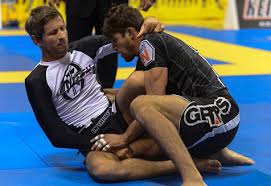It is not a secret to many people that know me that I am not a huge fan of no-gi training, especially in a self-defense context.
Mostly my opposition to it revolves around a couple of things.
- Unless we are anticipating fighting a greased up naked dude, there is a very good chance we will have handles of some kind that we can use to improve our chance of survival. This is not to say that those handles will always be the exact equivalent of gis, but more than likely they will be something that can be used in a similar fashion. Just having the knowledge and capability of controlling the sleeves/arms of the other guy and tying him up in a way that makes it hard for him to do something violent and offensive towards you may well be the single greatest technique to use in an entangled fight. I regularly teach, and have taught for more than 14 years, the ability for someone to use the choking strategies of BJJ and apply them to something as simple as a t-shirt. To this day, even against someone resisting violently, I have yet to have a t-shirt rip and render the choke impossible. With all that, it just makes sense that if we are truly focused on self-defense that spending the majority of our training time in the gi is a good thing.
- No-gi, as even its most vociferous proponents will agree, is a young man’s game. It relies on strength, speed, aggression, mobility, cardiovascular conditioning, etc. to be consistently successful. A heavy reliance which is great if you have those things but not so awesome if you don’t, and, let’s face it, it is far more likely to be true for those of us in the real world and just everyday people and not professional athletes in their physical prime. We cannot rely on those things to pull us through. In fact, we need to start with the premise that all of our opponents will be bigger, stronger, tougher, faster, meaner, more aggressive, less injured, have the initiative, and any other attribute we can think of. That needs to be our philosophical starting point.
Does that mean I am dead set against no-gi, or that I believe that is has no value at all for self-defense? I am in no way saying that. I think there are some spots that no-gi training shines, and while those spots may be less important or less necessary, does not meant they should be ignored.
Where no-gi shines is:
- You must actively and continuously be trying to control the other guy’s arms. Because there is no way to grab and lock down and just hold them, no-gi forces you into a very aggressive and constant attempt to secure as much control over the arms as possible. And if that control only lasts a moment, then you have to go right back to retrieving it. This is a great benefit in a self-preservation context because we must make sure that the other person cannot freely strike us or have free reign to deploy a weapon into the fight. Gi work gives you a better idea of how to control. And no-gi gets you used to fighting for it all the time.
- It is difficult and somewhat low percentage to fight from the bottom in no-gi. Even a great guard player is extremely restricted in his ability to attack, so the better strategy is to fight from the top or have back control. So in no-gi, you have to put a premium on constantly working to drive your hips over and to come up and be upright. And of course this may very well be the single best tactical plan if we are fighting for our lives in the street.
Even though I dislike no-gi, I do think that not only does it offer some value for self-defense, but it also is just good practice to work it on its own anyway. I follow Stephen Kesting’s dictum that BJJ training should be 80/20. 80% of the time do your preferred type or work, and 20% do the other, regardless of personal taste or preference.

